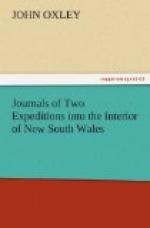June 10.—Remained at this station for the purpose of refreshing the people and horses. Examined the country to the north-east for a few miles; it differed but little from that already passed over, in point of quality of soil, but was broken into irregular hills and valleys, without rising into any one distinguishing or remarkable hill: the surface of the country seemed elevated, and rising to the eastward. The soil for the most part a reddish light mould, the hills covered with small stones, the trees dwarf gum, box, a few cypresses and casuarinae; the soil well covered with grass. Kangaroos, fish, and swans, were the produce of this day’s sport, so that we enjoyed all the necessaries, and many of the luxuries of life.
June 11.—Proceeded down the river about eight miles, meeting with no obstructions of any consequence: the water had risen about a foot in the last night, and now ran with considerable rapidity, particularly in the narrows. It is by no means desirable that the river should rise any higher; there is abundance of water for our purposes, any addition would only partially cover the stumps of trees and increase our danger; at present we see and avoid them. After travelling six miles we came to a small river running from the eastward; there was at this time a fresh in it, so that we had to unload the horses and use the boats to transport our baggage over. It was three o’clock before we had got every thing across, we therefore halted for the evening. The country passed through was of the finest description, and apparently equally good on the opposite side; rich flats bounded by gentle hills were on each side of the small river, which received the name of Erskine River, after the present lieutenant governor of the colony. These flats were covered with the species of eucalyptus called apple tree, but (like the other




